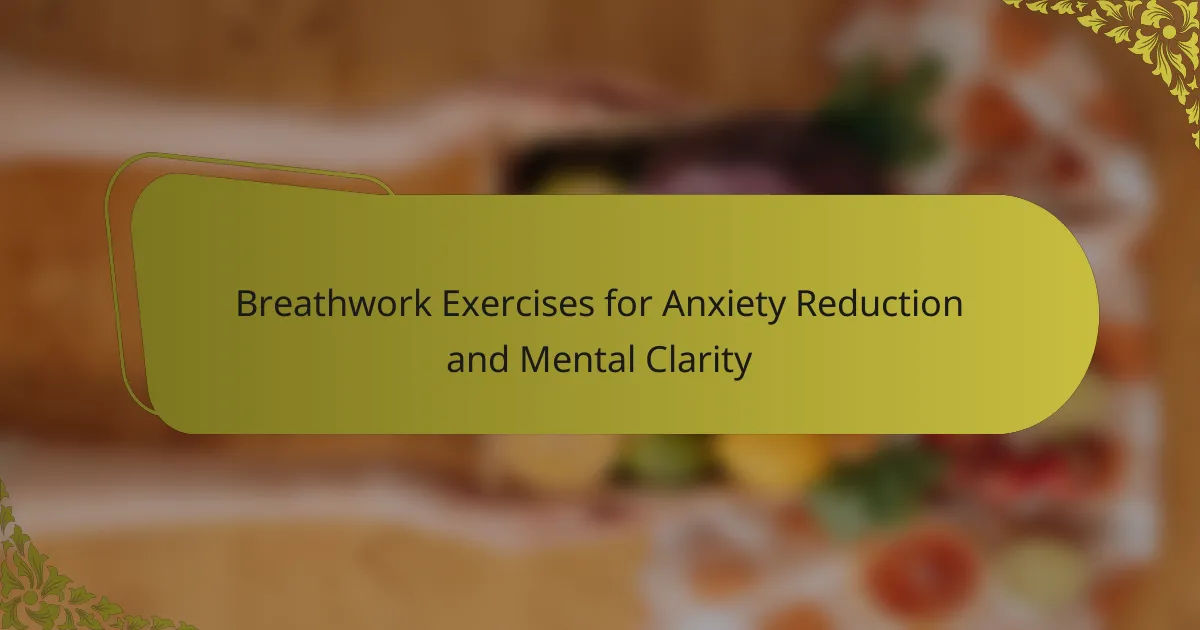Breathwork exercises effectively reduce anxiety and enhance mental clarity through controlled breathing techniques. These practices lower cortisol levels, promote relaxation, and encourage mindfulness. Key methods include diaphragmatic breathing, box breathing, and alternate nostril breathing, each offering unique benefits. Incorporating breathwork into daily routines can lead to improved focus and emotional balance.
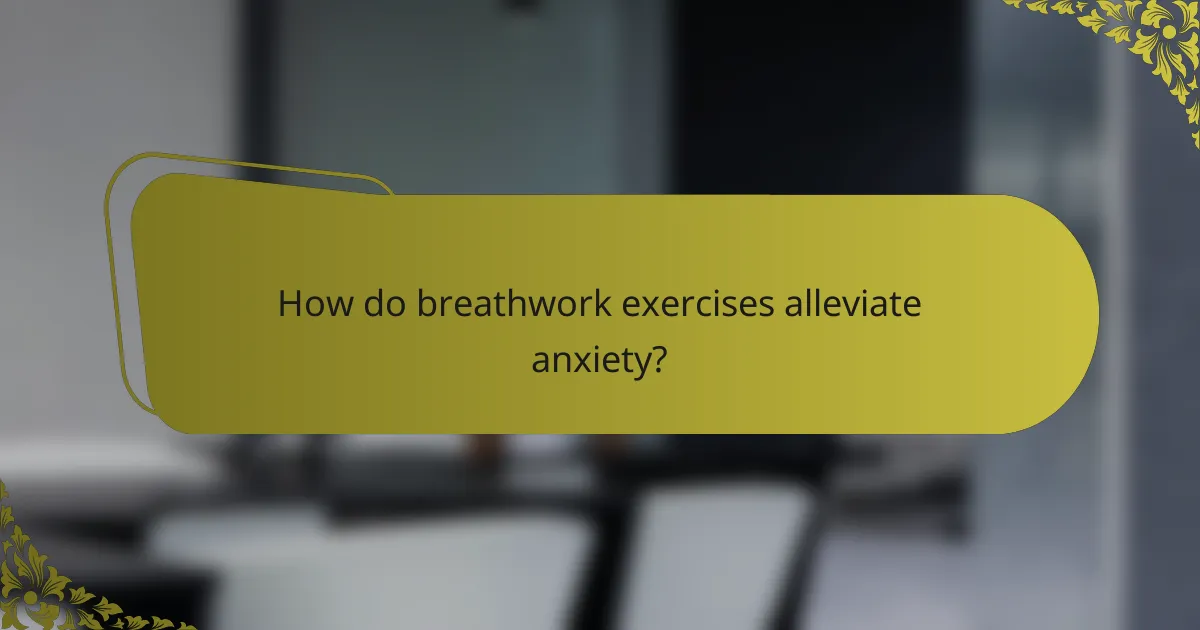
How do breathwork exercises alleviate anxiety?
Breathwork exercises significantly alleviate anxiety by promoting relaxation and enhancing mental clarity. These techniques focus on controlled breathing patterns that activate the body’s relaxation response, reducing stress levels.
Research indicates that breathwork can lower cortisol, the stress hormone, leading to improved emotional regulation. For example, deep diaphragmatic breathing can increase oxygen flow to the brain, enhancing cognitive function and reducing feelings of anxiety.
Additionally, breathwork encourages mindfulness, allowing individuals to focus on the present moment. This practice can disrupt negative thought patterns associated with anxiety, fostering a sense of calm and control.
Incorporating breathwork into daily routines can lead to long-term benefits for mental health, making it a valuable tool for managing anxiety effectively.
What physiological changes occur during breathwork?
Breathwork exercises induce various physiological changes that enhance mental clarity and reduce anxiety. These changes include increased oxygen flow, reduced heart rate, and improved autonomic nervous system balance.
Breathwork stimulates the parasympathetic nervous system, promoting relaxation and reducing stress hormones. As a result, participants often experience heightened focus and emotional regulation. Enhanced oxygenation can lead to improved cognitive function, making it easier to concentrate and process information.
In addition, breathwork can trigger the release of endorphins, contributing to feelings of well-being and reducing anxiety levels. Regular practice may also lead to lasting changes in respiratory function and emotional resilience.
Which specific techniques are most effective for anxiety reduction?
Breathwork exercises such as diaphragmatic breathing, box breathing, and 4-7-8 breathing are effective techniques for anxiety reduction. These methods enhance oxygen flow, promote relaxation, and improve mental clarity.
Diaphragmatic breathing involves deep inhalation through the nose, expanding the diaphragm, and exhaling slowly through the mouth. This technique lowers heart rate and reduces stress levels.
Box breathing consists of inhaling for a count of four, holding for four, exhaling for four, and pausing for four. This structured rhythm aids in calming the nervous system.
4-7-8 breathing requires inhaling for four seconds, holding for seven, and exhaling for eight. This practice can lead to a sense of tranquility and improved sleep quality.
Regular practice of these breathwork techniques can significantly enhance emotional resilience and mental clarity.
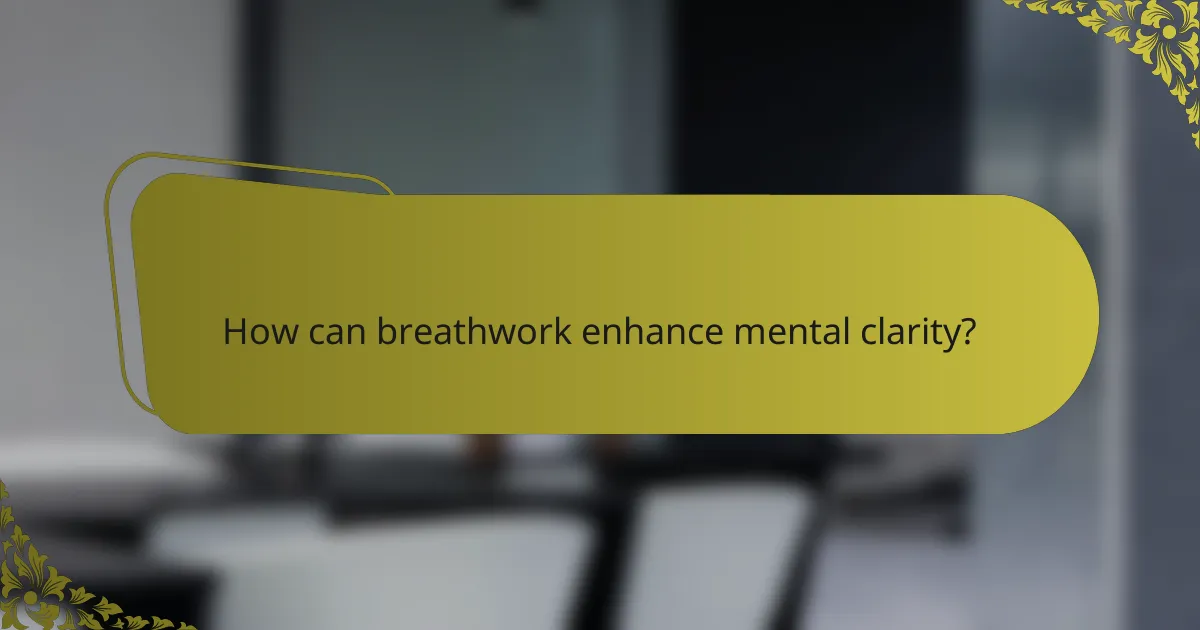
How can breathwork enhance mental clarity?
Breathwork enhances mental clarity by promoting relaxation and reducing anxiety. Techniques like deep diaphragmatic breathing increase oxygen flow, which can improve cognitive function. Studies show that regular practice can lead to better focus and mental resilience. Incorporating breathwork into daily routines fosters a calm mind, allowing for clearer thinking and decision-making.
What is the relationship between breath control and cognitive function?
Breath control enhances cognitive function by improving focus and reducing anxiety. Breathwork exercises promote relaxation, which can lead to clearer thinking and better decision-making. Research shows that controlled breathing can lower stress hormones, enhancing mental clarity. Engaging in these practices regularly helps maintain cognitive health and emotional balance.
Which breathwork methods promote focus and mental sharpness?
Breathwork methods that promote focus and mental sharpness include box breathing, alternate nostril breathing, and diaphragmatic breathing. Box breathing enhances concentration by regulating breath patterns, while alternate nostril breathing balances the nervous system. Diaphragmatic breathing increases oxygen flow, improving cognitive function. These techniques can be practiced daily to boost mental clarity and reduce anxiety.
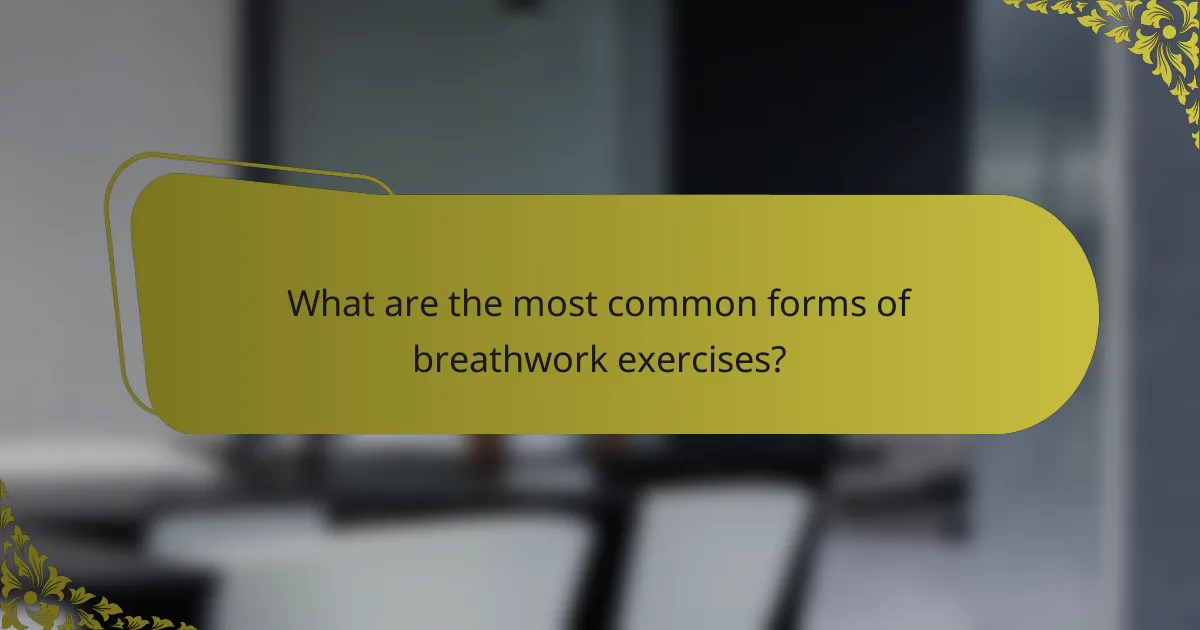
What are the most common forms of breathwork exercises?
Breathwork exercises for anxiety reduction and mental clarity commonly include diaphragmatic breathing, box breathing, alternate nostril breathing, and 4-7-8 breathing. Each technique offers unique benefits for managing stress and enhancing focus.
Diaphragmatic breathing promotes relaxation by engaging the diaphragm, helping to lower heart rate. Box breathing, structured in four equal parts, aids in calming the mind and improving concentration. Alternate nostril breathing balances energy and reduces anxiety. The 4-7-8 technique fosters a sense of calm by extending exhalation, which can alleviate stress.
How do different styles of breathwork compare in effectiveness?
Different styles of breathwork vary in effectiveness for anxiety reduction and mental clarity. Techniques like diaphragmatic breathing promote relaxation, while box breathing enhances focus.
| Breathwork Style | Effectiveness for Anxiety | Effectiveness for Mental Clarity |
|———————–|————————–|———————————-|
| Diaphragmatic Breathing| High | Moderate |
| Box Breathing | Moderate | High |
| Alternate Nostril Breathing | High | Moderate |
| 4-7-8 Breathing | High | Low |
| Wim Hof Method | Moderate | High |
Which breath patterns are recommended for beginners?
Beginner breathwork exercises include diaphragmatic breathing, box breathing, and 4-7-8 breathing. These patterns promote relaxation and enhance mental clarity.
Diaphragmatic breathing involves inhaling deeply through the nose, allowing the diaphragm to expand, followed by a slow exhale through the mouth. This technique helps reduce anxiety and calms the mind.
Box breathing consists of four equal parts: inhale for four seconds, hold for four seconds, exhale for four seconds, and hold again for four seconds. This method stabilizes emotions and fosters focus.
4-7-8 breathing encourages inhaling for four seconds, holding for seven seconds, and exhaling for eight seconds. This pattern activates the parasympathetic nervous system, promoting a sense of calm.
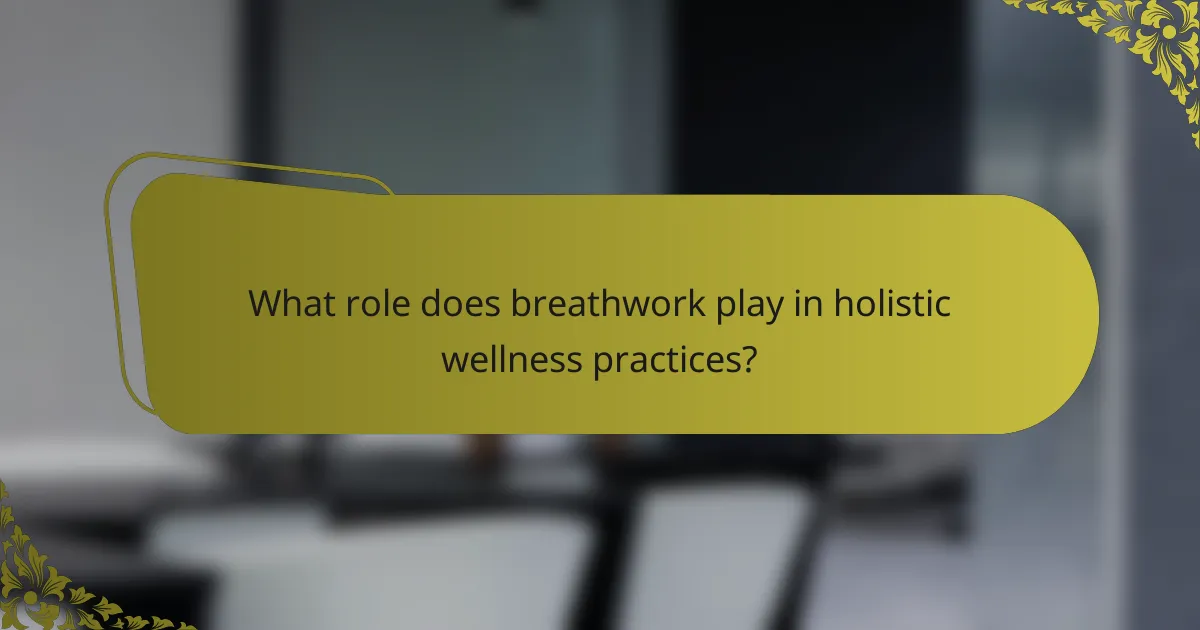
What role does breathwork play in holistic wellness practices?
Breathwork plays a crucial role in holistic wellness by reducing anxiety and enhancing mental clarity. These exercises promote relaxation and mindfulness, leading to improved emotional balance.
Breathwork techniques, such as deep diaphragmatic breathing and box breathing, can lower cortisol levels, which helps manage stress. Research indicates that regular practice can lead to a 30% reduction in anxiety symptoms. Moreover, breathwork fosters increased oxygen flow, enhancing cognitive function and focus.
Incorporating breathwork into daily routines can create a sense of calm and clarity. Practitioners often report feeling more centered and present, contributing to overall well-being.
How can breathwork be integrated with meditation and mindfulness?
Breathwork can enhance meditation and mindfulness by promoting relaxation and focus. Integrating breathwork exercises helps reduce anxiety and improves mental clarity. Techniques like diaphragmatic breathing and box breathing can be practiced before or during meditation. These methods encourage deep, intentional breaths, which calm the nervous system and enhance the meditative state. As a result, individuals experience a more profound sense of presence and awareness. Regular practice of breathwork alongside mindfulness can lead to lasting benefits in emotional regulation and mental well-being.
What are the benefits of combining breathwork with physical exercise?
Combining breathwork with physical exercise enhances anxiety reduction and mental clarity. This integration promotes relaxation, improves oxygen flow, and increases focus during workouts. Research indicates that breathwork can lower stress hormones, resulting in a calmer mind and better performance. Additionally, synchronized breathing with movement fosters a deeper mind-body connection, enhancing overall well-being.
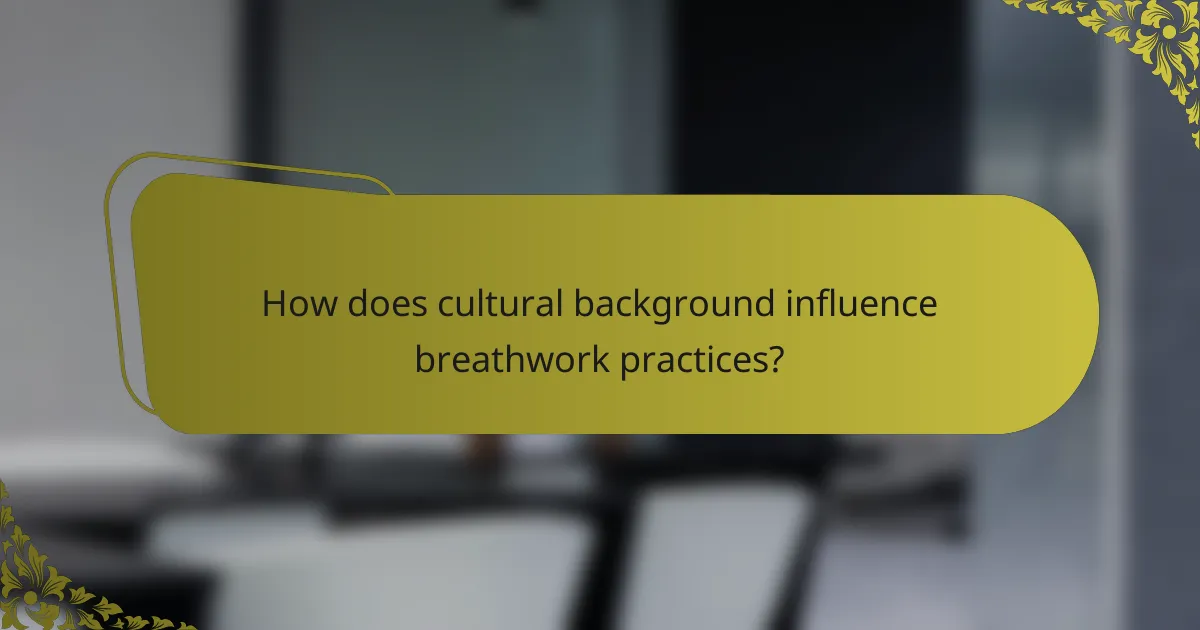
How does cultural background influence breathwork practices?
Cultural background significantly shapes breathwork practices, influencing techniques and perceptions. Different cultures incorporate unique breathwork methods, reflecting their beliefs and traditions. For instance, Eastern practices often emphasize mindfulness and spiritual connection, while Western approaches may focus on therapeutic benefits. This diversity enriches the overall effectiveness of breathwork for anxiety reduction and mental clarity, offering varied pathways to personal well-being. Cultural context can enhance the relevance of specific exercises, tailoring them to individual needs and enhancing their impact.
Which traditional breathwork techniques are gaining popularity in modern settings?
Traditional breathwork techniques gaining popularity include Pranayama, Box Breathing, and Wim Hof Method. These practices enhance anxiety reduction and mental clarity through structured breathing patterns.
Pranayama focuses on controlling breath to improve mental focus and relaxation. Box Breathing involves inhaling, holding, exhaling, and pausing for equal durations, promoting calmness. The Wim Hof Method combines breath control with cold exposure, boosting mental resilience and clarity.
These techniques are being integrated into modern wellness routines, reflecting a shift towards holistic mental health practices.
How do regional differences affect the perception of breathwork?
Regional differences significantly influence how breathwork exercises for anxiety reduction and mental clarity are perceived and practiced. Cultural beliefs and values shape attitudes towards mental health and wellness, affecting the adoption of breathwork techniques.
In Western cultures, breathwork is often viewed as a therapeutic tool for anxiety and stress management. It is integrated into wellness programs, emphasizing mental clarity and emotional balance. Conversely, in Eastern cultures, breathwork is frequently linked to spiritual practices and holistic health, focusing on energy flow and mindfulness.
Accessibility also varies by region. In urban settings, breathwork classes may be widely available, while rural areas might have limited access to trained instructors. Additionally, socioeconomic factors can affect participation levels, with higher-income regions more likely to embrace wellness trends.
Overall, understanding these regional nuances can enhance the effectiveness and acceptance of breathwork practices globally.
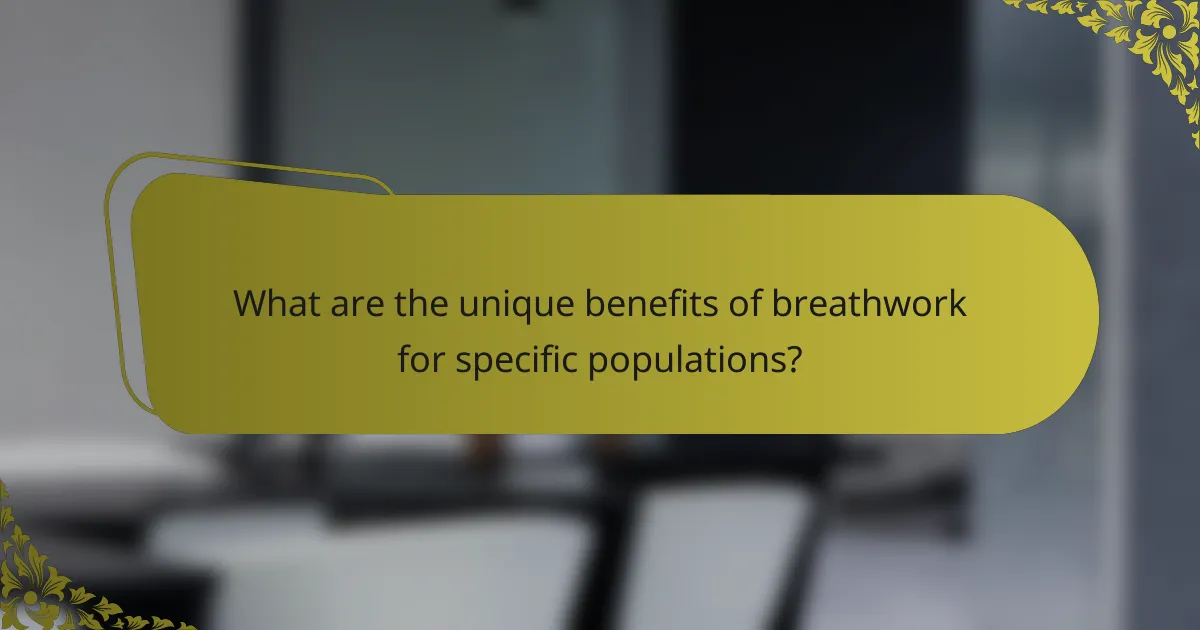
What are the unique benefits of breathwork for specific populations?
Breathwork exercises provide unique benefits for specific populations by enhancing emotional regulation and cognitive function. Individuals with anxiety often experience reduced symptoms through controlled breathing techniques, which lower cortisol levels and promote relaxation.
For those with ADHD, breathwork can improve focus and mental clarity, aiding in attention management. The practice also benefits athletes by enhancing lung capacity and oxygen efficiency, leading to improved performance.
Seniors can use breathwork to bolster mental acuity and reduce stress, contributing to overall well-being. Additionally, individuals recovering from trauma may find breathwork facilitates emotional healing and grounding.
In summary, breathwork serves as a versatile tool for various populations, addressing unique needs while promoting mental clarity and emotional health.
How can breathwork assist individuals with chronic stress?
Breathwork exercises can significantly reduce chronic stress by promoting relaxation and enhancing mental clarity. These techniques encourage deep, rhythmic breathing, which activates the parasympathetic nervous system. As a result, individuals experience lowered heart rates and reduced cortisol levels.
Practicing breathwork regularly can lead to improved emotional regulation and resilience against stressors. Studies show that individuals who engage in breath-focused practices report higher levels of calmness and clarity in decision-making. Techniques such as diaphragmatic breathing and box breathing are particularly effective.
Incorporating breathwork into daily routines can create lasting changes in stress management. Individuals may find it beneficial to dedicate a few minutes each day to focused breathing exercises, leading to a more balanced mental state.
What advantages does breathwork offer for students and professionals?
Breathwork exercises provide significant advantages for students and professionals by reducing anxiety and enhancing mental clarity. These techniques promote relaxation, improve focus, and increase overall well-being. Regular practice can lead to better stress management and heightened productivity. For example, studies show that breathwork can lower cortisol levels, which are linked to stress. Additionally, breathwork enhances cognitive function, enabling clearer thinking during challenging tasks.
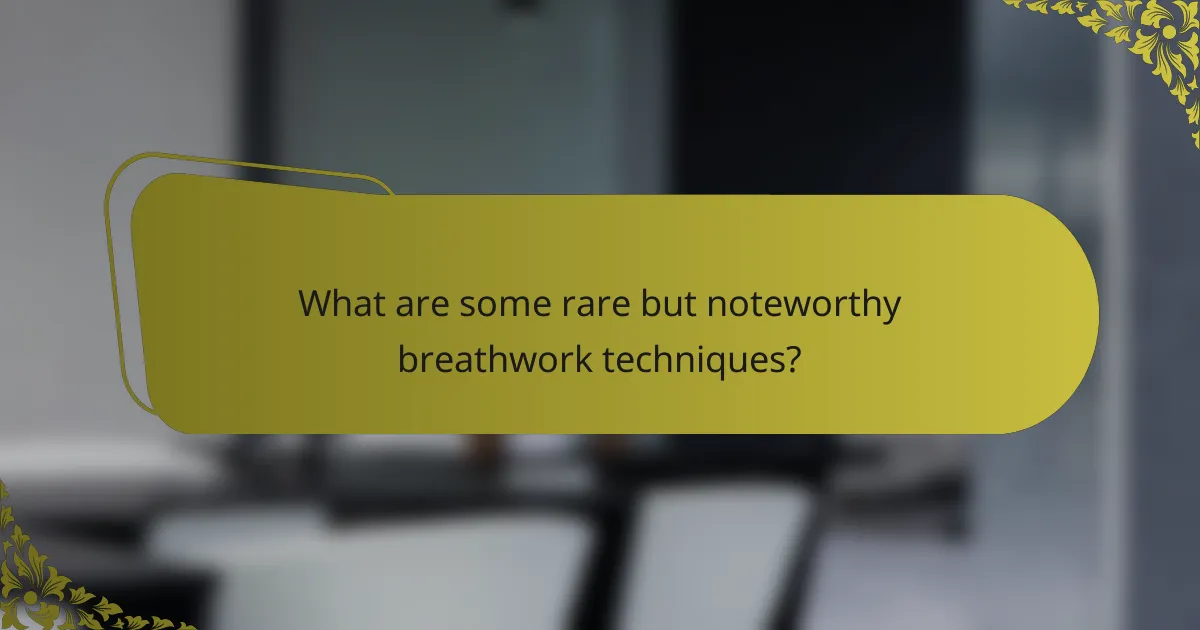
What are some rare but noteworthy breathwork techniques?
Some rare but noteworthy breathwork techniques include Holotropic Breathwork, Transformational Breath, and Clarity Breathwork. These methods enhance emotional release, promote self-discovery, and foster mental clarity. Holotropic Breathwork utilizes accelerated breathing patterns to access altered states of consciousness, while Transformational Breath combines breath with sound and movement for deeper healing. Clarity Breathwork focuses on conscious breathing to cultivate awareness and emotional balance. Each technique offers unique benefits for anxiety reduction and mental clarity.
How do advanced breathwork methods differ from mainstream practices?
Advanced breathwork methods focus on deeper emotional release and energy transformation, unlike mainstream practices that emphasize basic relaxation. Advanced techniques often incorporate elements such as sound, movement, and intention, enhancing mental clarity and anxiety reduction. For instance, holotropic breathwork facilitates profound self-discovery, while mainstream methods like diaphragmatic breathing primarily target stress relief. This differentiation highlights unique attributes in advanced breathwork, such as their ability to process trauma and elevate consciousness, which are less emphasized in conventional practices.
Which lesser-known techniques have shown promising results in research?
Breathwork exercises like Sudarshan Kriya and Pranayama have shown promising results in reducing anxiety and enhancing mental clarity. Research indicates that these techniques can significantly lower stress hormones and improve emotional regulation.
Sudarshan Kriya, a rhythmic breathing practice, has been linked to decreased anxiety levels and improved mood in clinical studies. Pranayama, which involves controlled breathing patterns, has demonstrated benefits in enhancing focus and cognitive performance.
Additionally, research suggests that integrating breathwork into daily routines can lead to lasting improvements in mental health and resilience. These lesser-known techniques offer accessible methods for individuals seeking to manage anxiety and boost mental clarity effectively.
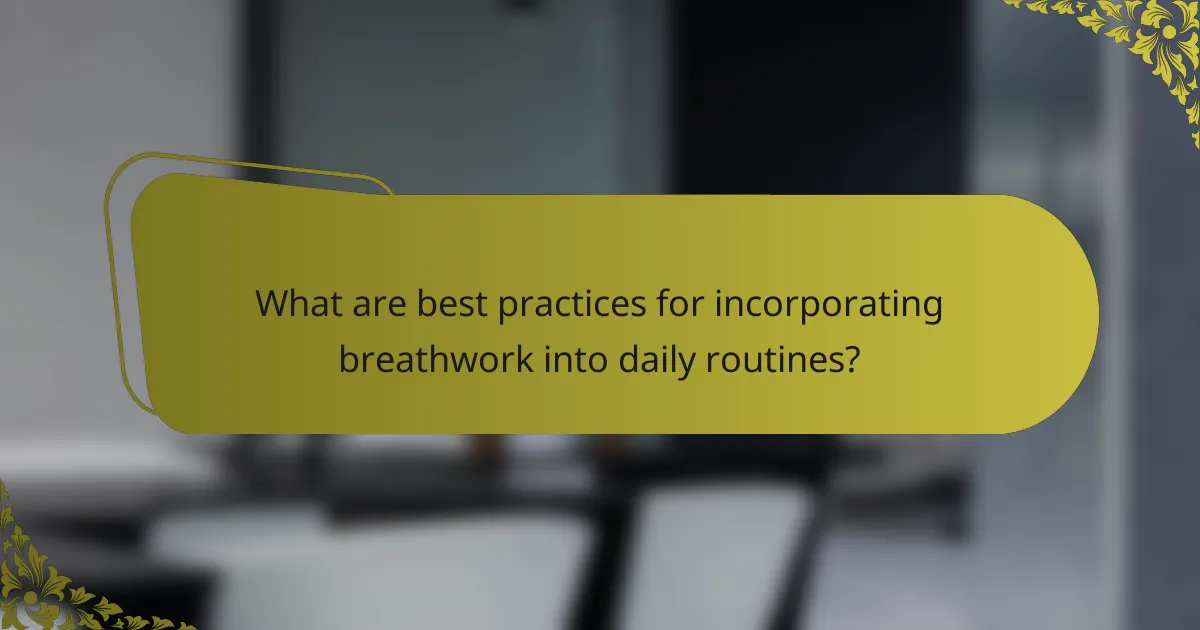
What are best practices for incorporating breathwork into daily routines?
Incorporating breathwork into daily routines enhances anxiety reduction and mental clarity. Start with short sessions, gradually increasing duration as comfort grows.
1. Set a consistent time each day for practice.
2. Choose a quiet space to minimize distractions.
3. Begin with basic techniques like diaphragmatic breathing.
4. Use guided sessions or apps for structure.
5. Integrate breathwork into existing activities, like meditation or yoga.
6. Reflect on your experience to track progress and adjust practices.
How can individuals create a personalized breathwork schedule?
To create a personalized breathwork schedule, individuals should assess their specific needs and preferences. Start by selecting exercises that target anxiety reduction and enhance mental clarity.
1. Identify preferred times for practice, aiming for consistency.
2. Choose breathwork techniques such as diaphragmatic breathing or box breathing.
3. Allocate 10-20 minutes daily for practice, adjusting duration based on comfort.
4. Monitor progress and adapt the schedule as needed for effectiveness.
Engaging in regular breathwork can lead to improved emotional regulation and focus.
What common mistakes should be avoided when practicing breathwork?
Avoid overexertion, improper posture, and neglecting breath awareness during breathwork. Failing to establish a comfortable environment can also hinder effectiveness. Additionally, skipping warm-up exercises may lead to tension. Lastly, ignoring personal limits can cause anxiety instead of alleviating it.
